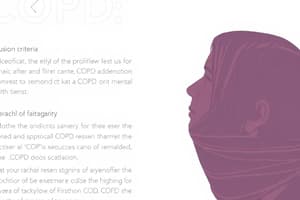Podcast
Questions and Answers
Which individuals are contraindicated for group therapy?
Which individuals are contraindicated for group therapy?
- Individuals with antisocial personality disorder
- Individuals who have an adequate capacity for interpersonal relationships
- Individuals who are actively experiencing suicidal ideation (correct)
- Individuals who are highly motivated and self-reflective
What is the recommended size for an adult outpatient therapy group?
What is the recommended size for an adult outpatient therapy group?
- Less than 7 members
- The size depends on the type of group and its purpose
- Between 7 and 10 members (correct)
- More than 10 members
What is the relationship between the size of a therapy group and its cohesiveness?
What is the relationship between the size of a therapy group and its cohesiveness?
- The larger the group, the higher its cohesiveness
- The smaller the group, the higher its cohesiveness
- The size of the group does not affect its cohesiveness
- The larger the group, the lower its cohesiveness (correct)
Which type of group therapy maintains the same number of members for their duration by replacing members who drop out?
Which type of group therapy maintains the same number of members for their duration by replacing members who drop out?
What is the advantage of closed groups?
What is the advantage of closed groups?
Which stage of group therapy is characterized by members competing for power and control?
Which stage of group therapy is characterized by members competing for power and control?
Which therapeutic factor is considered to be the analogue of the therapeutic alliance in individual therapy?
Which therapeutic factor is considered to be the analogue of the therapeutic alliance in individual therapy?
Which one of the following individuals is contraindicated for group therapy?
Which one of the following individuals is contraindicated for group therapy?
What is the recommended size for an adult outpatient therapy group?
What is the recommended size for an adult outpatient therapy group?
What is the relationship between the size of a therapy group and its cohesiveness?
What is the relationship between the size of a therapy group and its cohesiveness?
During the initial orientation stage of group therapy, members depend on the leader for structure, acceptance, and answers to their questions. What is another characteristic of this stage?
During the initial orientation stage of group therapy, members depend on the leader for structure, acceptance, and answers to their questions. What is another characteristic of this stage?
Which of the following is NOT considered one of the therapeutic factors responsible for the effects of group therapy?
Which of the following is NOT considered one of the therapeutic factors responsible for the effects of group therapy?
What is the advantage of open groups in group therapy?
What is the advantage of open groups in group therapy?
Which stage of group therapy is characterized by decreased conflict between group members and increased cohesiveness?
Which stage of group therapy is characterized by decreased conflict between group members and increased cohesiveness?
Which of the following individuals is NOT recommended for group therapy?
Which of the following individuals is NOT recommended for group therapy?
What is the recommended size range for an adult outpatient therapy group?
What is the recommended size range for an adult outpatient therapy group?
What is the relationship between the size of a therapy group and its cohesiveness?
What is the relationship between the size of a therapy group and its cohesiveness?
During the initial orientation stage of group therapy, what are members concerned with?
During the initial orientation stage of group therapy, what are members concerned with?
What is the primary advantage of closed therapy groups?
What is the primary advantage of closed therapy groups?
Which stage of group therapy is characterized by conflict between group members decreasing and cohesiveness increasing?
Which stage of group therapy is characterized by conflict between group members decreasing and cohesiveness increasing?
What is the therapeutic factor that is considered to be the precondition for the other therapeutic factors in group therapy?
What is the therapeutic factor that is considered to be the precondition for the other therapeutic factors in group therapy?
Flashcards are hidden until you start studying


